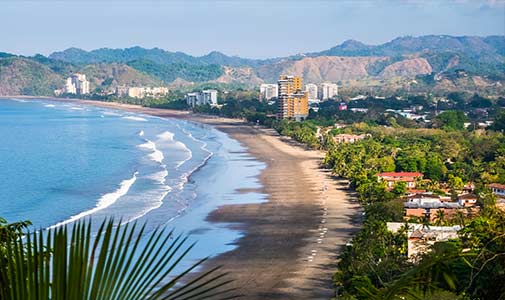Emanuel N. Says:
I’ve always dreamed of living by the beach in Costa Rica. Would my wife and I be able to get by there on my Social Security of $2,000 a month?
 IL Latin America Correspondent Jason Holland Says:
IL Latin America Correspondent Jason Holland Says:
Hi Emanuel,
Costa Rica has a lot going for it as a place to live and retire: natural beauty, exotic wildlife, warm weather year-round, beautiful beaches, warm and welcoming people…the list goes on. But one of the most attractive features of life in this tropical Central American country is the lower cost of living.
Retired couples can live well on $2,000 per month in expenses, including housing, transportation, food, medical…everything. I know some couples who’ve got it down to $1,500 a month. Of course, you can live even better for $2,500…$3,000…or even more per month, as many expats do.
You will not reach that low level of spending if you buy a lot of imported items at the grocery store or need to have the latest electronic gadget when it comes on the market. Imported items are expensive in Costa Rica due to heavy customs duties.
On the flipside, neither will you have to subsist on rice and beans. You can live a great lifestyle on a low budget with plenty of travel, fun with friends, and more.
One important thing to remember is to shop like a local. In just about every Costa Rican town there is a weekly ritual for residents: a shopping trip to the feria, or farmers’ market. It’s where locals load up with fresh fruits, vegetables, and herbs. You can also pick up dairy products, fish, chicken, beef, pet food, honey, flowers, coffee, bread…basically anything not processed and put in a box on the grocery store shelf.
It’s fresh-off-the-farm and cheap. Lettuce is $1 a head. Bananas—75 cents a pound. Avocados—four for $2. A dozen eggs—$3. Expat couples usually spend about $40 or so for a week’s worth of food. Plus, going to the feria is fun too, with the vendors offering free samples and calling out deals all surrounded by tables piled high with produce.
You should also eat like a local. You can find plenty of fast food in Costa Rica. McDonald’s, Pizza Hut, and such all have a big presence here. And in the larger towns, especially the tourist-oriented beach towns, and the capital, San José, you can also find plenty of gourmet options. But the prices at these places are about the same as in the U.S.
So, if you’re ready to eat cheap and healthy when you dine out, just like at home (remember, you’ve been shopping at the farmers’ market), you have to eat out like a local. And that means patronizing the small neighborhood restaurants known as sodas. These places all have basically the same menu with little tweaks here and there. The casado is the national dish. It features rice, beans, plantains, salad, and your choice of meat, chicken, or fish. Between $5 and $9 a plate, depending on where you are. You can also get arroz con pollo—chicken with rice—or other similar dishes. And ceviche is also a popular choice. It’s fresh fish “cooked” in lime juice and served with chopped-up onions and peppers. Usually about $7 for a healthy portion.
You should also think about whether or not you need a car. The bus network in Costa Rica is widespread and efficient. You can get from outlying areas into town, around town, from town to town, and across the country easily on the bus. Many ticos don’t have cars or maybe just one for the household, so the bus system is well-used and appreciated. Costs are low, about 75 cents for a local bus, $5 if you’re traveling a half-hour to an hour to another town, or $10 to $20 if you’re going across country. Local buses run every hour or half-hour, although larger cities have more frequent service.
It’s important to keep in mind that for any particular line item, figures will vary depending on location. Costs in popular coastal communities tend to be 10% to 25% higher than they are in the Central Valley.
Use this as a guide to guestimate your needed budget. The figures below represent a price that is doable, but not necessarily extravagant.
| Expense | U.S. $ |
| Rent (furnished, two-bedroom home) | $800 |
| Electricity | $50 |
| Water | $10 |
| Internet | $40 |
| Cellphones | $30 |
| Cable TV | $60 |
| Clothing | $50 |
| Healthcare | $150 |
| Food/groceries (including alcohol | $400 |
| Entertainment | $250 |
| Misc | $100 |
| Total | $1,940 |
Got a Question?
Send your thoughts to mailbag@internationalliving.com. We’ll post and respond to as many of your emails as we can right here in the e-letter.


